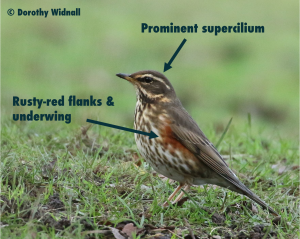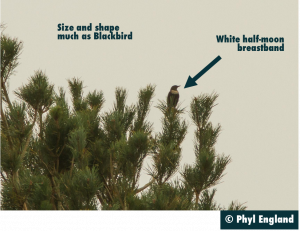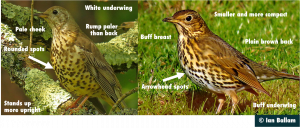
Redwing
October migration is magnificent, and there’s no better example than the arrival of our handsome winter thrushes. Huge numbers travel overnight from their Scandinavian breeding grounds to arrive on our shores from the break of dawn, desperate to feast on our plentiful supply of autumnal fruits and berries. The harsh chack chack chack of the Fieldfare and the thin, descending tseee of the Redwing are a joy to listen to on dark autumn nights as flocks pile over our homes overnight. Having left the Dutch coastline at dusk, they navigate their way through the darkness using singular calls to stay in contact with one another until sunrise. As dawn breaks, they form large flocks and follow visual landmarks before dropping out of the sky to feed. Of the six thrush species that regularly occur in the UK, most make frequent movements across the UK to settle for winter, although our breeding Mistle Thrush populations exhibit little seasonal movement. The first tseee calls of Redwing arriving into Dorset have already been heard in recent nights and Song Thrush have been on the move too, with more Continental immigrants set to arrive imminently, supplementing our local breeders.
Let’s begin by looking at a garden staple, the Common Blackbird. Instantly recognisable and regularly encountered throughout the year, come late October, tens of thousands arrive into the UK from Scandinavia to join our local breeding population. We are most familiar with their beautiful, full-bodied songs as a soundtrack throughout our summer months. However, at night, their tuneful songs are exchanged for a subtler nocturnal call. The Blackbird’s srrri flight calls are similar to that of Redwing, but are shorter and do not descend in frequency as markedly. They also have a diagnostic modulating quality, appearing as though the call is delivered at a slower speed than Redwing.
Take a close listen to the recordings below, headphones recommended. Familiarise yourself with the first two examples which contain single nocturnal calls of Redwing and Blackbird, respectively. The third recording captures the nocturnal passage of a mixed thrush flock.
1. Single Redwing tseee call. NB: frequency and descending quality
2. Single Blackbird srrri call. NB: modulating quality
3. Redwing, Blackbird & Song Thrush Passage
During the spring, Song Thrush give themselves away with their masterfully rich song. However, in autumn a single tic is all that’s offered as they flies over our gardens at first light, having travelled overnight in huge numbers from northern Europe. The sharp-eyed/eared may have noticed that Song Thrush calls appear in the previous recording, and these unobtrusive flight calls are hidden among the stronger Redwing and Blackbird calls. Revisit the previous recording to listen out for the subtle tic of the Song Thrush after exploring the below recording which provides an example of an isolated nocturnal flight call.
4. Single Song Thrush tic call
5. Fieldfare
Significantly rarer than our other autumn thrushes, Ring Ouzel are a late migrating summer visitor that are currently returning to Africa for the winter, often accompanying flocks of their Scandinavian cousins during their journey south. Ring Ouzel are annually reported from Ballard Down. Arne, Hartland, Slepe Heath, Lytchett Bay and Ham Common all hold recent records, but unfortunately it’s not an easy bird to catch up with in the field. Most recently, a couple of individuals have been kicking around Godlingston Hill Gully. However, Autumn 2016 saw a huge number passing through the UK, with birds turning up at urban sites in Poole including the Fleets Corner, PC World Drain! Listen out for their tongue-tutting tock tock tock calls, delivered in rapid outbursts for the best chance to observe these scarce summer migrants.
6. Ring Ouzel Passage

Ring Ouzel
And finally, the only non-nocturnal thrush is the Mistle Thrush, which loves to feed on Rowan berries during October in flocks of between 10-50 before dispersing later in the month to areas unknown! Often confused with the smaller, more compact Song Thrush, use our plate below to help separate these two confusing species.

Comparison of Mistle Thrush (left) and Song Thrush (right)
South Haven is excellently situated to witness huge cold weather movements. A typical cold weather movement can consist of an impressive 6,000 to 10,000 birds. But you don’t need to travel to experience huge numbers, a recent study recorded over 3,000 Redwing passing over Poole Town centre in a single night! To spot these striking winter visitors during the day, try visiting large fields or fruit bearing bushes which provide much needed feeding opportunities. Great sites to work include Lytchett Bay, Soldiers Road, Upton Country Park, RSPB Arne, Bestwall and Upton Heath.
So, rather than retreating to your warm lounges and comfy sofas as the month progresses, venture out and welcome the arrival of our hardy winter thrushes.
Still plenty of winter birds around despite the recent summer-like weather with 511 Black-tailed Godwit in Holes Bay…
Find out moreIt’s always worth checking all these Red Kite that have been passing through, with a probable Black Kite…
Find out more© 2025 Birds of Poole Harbour Registered Charity No. 1152615